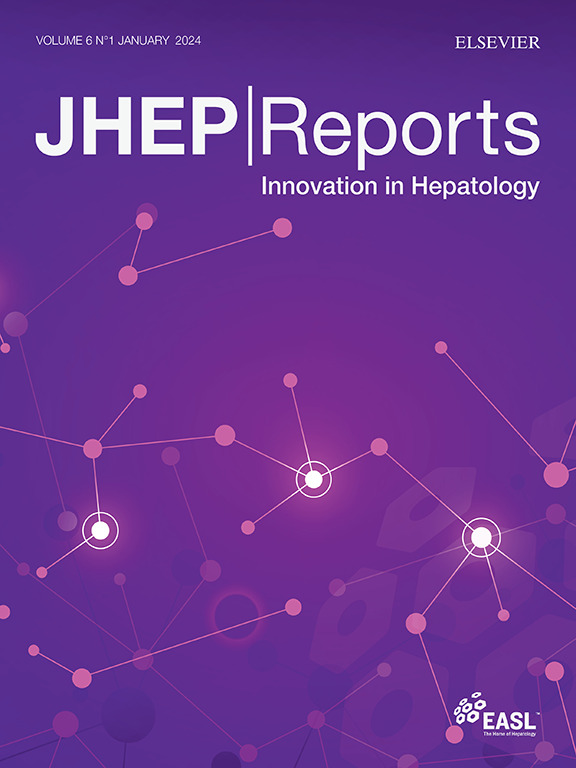在现实世界中,奥贝胆酸治疗PBC的长期有效性、安全性和肝脏硬度动态
IF 7.5
1区 医学
Q1 GASTROENTEROLOGY & HEPATOLOGY
引用次数: 0
摘要
背景,几项研究评估了奥贝胆酸(OCA)在现实世界中的短期有效性和安全性。我们的目的是通过扩大样本量和随访,以及通过探索肝硬度测量(LSM)随时间的变化,来扩展对OCA治疗的实际有效性和安全性的了解。方法RECAPITULATE项目涉及属于“意大利PBC登记处”和/或“Ospedalieri俱乐部”PBC工作组的中心。根据POISE和正常范围(NR)标准(正常碱性磷酸酶/丙氨酸转氨酶/胆红素)评价生化反应的有效性。安全性评估为新发/恶化瘙痒的发生率和停药率/原因。还捕获了可用的lsm。结果:我们纳入了来自66个意大利中心的747例患者:平均年龄58岁;女性/男性88% / 14%;中位随访24个月[IQR 12-42];28%为肝硬化,14%为自身免疫性肝炎(AIH)/PBC重叠综合征。到第42个月,POISE和NR应答的概率分别从基线增加到57%和20%。肝硬化患者的缓解概率较低(POISE和NR分别为p = 0.02和p = 0.004),但AIH/PBC患者与单纯PBC患者之间无差异(p = 0.8)。总体而言,130名患者(17%)停止治疗,主要是由于瘙痒(36.9%),而28.5%的患者在发生肝脏事件后停止治疗。肝硬化患者的停药率更高(p <0.001)。573例(约77%)患者可获得LSM,其中255例有多次测量。LSM随时间的变化取决于是否达到POISE生化反应(应答者的预期平均年变化分别为-0.48[-0.78,-0.19]和+0.33 [-0.07,0.73],p <0.001)。结论我们的研究结果证实了OCA中长期的有效性和安全性,并表明生化反应与LSM随时间的变化有关。影响和意义在OCA治疗PBC的有条件批准后,主要的验证性研究未能证明OCA减少肝脏相关事件的能力,导致EMA撤销了该药的上市许可。随之而来的科学辩论凸显了迫切需要从现实世界的实践中获得进一步的证据。在迄今为止使用OCA治疗的最大的现实世界患者系列中,我们确认该药物的有效性和安全性在中长期随访期间保持不变。该研究还为相关亚组患者(如肝硬化和自身免疫性肝炎/PBC重叠综合征)的药物管理提供了有价值的数据。我们关于肝脏硬度测量随时间变化的原始结果表明,OCA对纤维化进展有有利影响,特别是在对药物产生生化反应的患者中。总的来说,这些数据为临床医生管理PBC患者提供了重要的见解,并有助于正在进行的关于该药物有效性/安全性的科学辩论。本文章由计算机程序翻译,如有差异,请以英文原文为准。

Long-term effectiveness, safety, and liver stiffness dynamics of PBC treatment with obeticholic acid in real-world
Background & Aims
Several studies have assessed the short-term effectiveness and safety of obeticholic acid (OCA) in the real-world setting. We aimed to extend knowledge on the real-world effectiveness and safety of OCA treatment by expanding sample size and follow-up, and by exploring changes in liver stiffness measurement (LSM) over time.
Methods
The RECAPITULATE project involves centres belonging to the “Italian PBC registry” and/or the “Club Epatologi Ospedalieri” PBC working group. Effectiveness was evaluated as biochemical response according to POISE and normal range (NR) criteria (normal alkaline phosphatase/alanine aminotransferase/bilirubin). Safety was assessed as the incidence of de novo/worsening pruritus and discontinuation rate/causes. Available LSMs were also captured.
Results
We included 747 patients from 66 Italian centres: mean age 58 years; female/male 88%/14%; median follow-up 24 months [IQR 12-42]; 28% with cirrhosis, and 14% with autoimmune hepatitis (AIH)/PBC overlap syndrome. Probabilities of POISE and NR response increased from baseline to 57% and 20%, respectively, by the 42nd month. The probabilities of response were lower in patients with cirrhosis (p = 0.02 and p = 0.004 for POISE and NR), but not different between patients with AIH/PBC and pure PBC (p = 0.8). Overall, 130 patients (17%) discontinued treatment, mainly due to pruritus (36.9%), while 28.5% did so after developing hepatic events. The discontinuation rate was higher in patients with cirrhosis (p <0.001). LSM was available in 573 patients (∼77%), of whom 255 had multiple measurements. LSM variation over time differed based on the attainment of POISE biochemical response (expected mean annual variation -0.48 [-0.78, -0.19] in responders vs. +0.33 [-0.07, 0.73] in non-responders, respectively, p <0.001).
Conclusions
Our findings confirm the effectiveness and safety profiles of OCA in the medium/long term and demonstrate that biochemical response is associated with the change in LSM over time.
Impact and Implications
After the conditional approval of OCA for the treatment of PBC, the main confirmatory study failed to demonstrate OCA's ability to reduce liver-related events, leading the EMA to revoke the drug's marketing authorization. The ensuing scientific debate highlights an urgent need for further evidence from real-world practice. In the largest real-world series of patients treated with OCA to date, we confirm that the drug's effectiveness and safety profiles are maintained over a medium-to-long follow-up period. Valuable data for the management of the drug in relevant subgroups of patients, such as those with cirrhosis and autoimmune hepatitis/PBC overlap syndrome, are also provided. Our original results on liver stiffness measurement variation over time suggest a favourable impact of OCA on fibrosis progression, particularly in patients achieving a biochemical response to the drug. Overall, these data provide important insights for clinicians managing patients with PBC and contribute to the ongoing scientific debate about the effectiveness/safety profile of this drug.
求助全文
通过发布文献求助,成功后即可免费获取论文全文。
去求助
来源期刊

JHEP Reports
GASTROENTEROLOGY & HEPATOLOGY-
CiteScore
12.40
自引率
2.40%
发文量
161
审稿时长
36 days
期刊介绍:
JHEP Reports is an open access journal that is affiliated with the European Association for the Study of the Liver (EASL). It serves as a companion journal to the highly respected Journal of Hepatology.
The primary objective of JHEP Reports is to publish original papers and reviews that contribute to the advancement of knowledge in the field of liver diseases. The journal covers a wide range of topics, including basic, translational, and clinical research. It also focuses on global issues in hepatology, with particular emphasis on areas such as clinical trials, novel diagnostics, precision medicine and therapeutics, cancer research, cellular and molecular studies, artificial intelligence, microbiome research, epidemiology, and cutting-edge technologies.
In summary, JHEP Reports is dedicated to promoting scientific discoveries and innovations in liver diseases through the publication of high-quality research papers and reviews covering various aspects of hepatology.
 求助内容:
求助内容: 应助结果提醒方式:
应助结果提醒方式:


